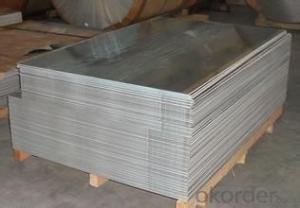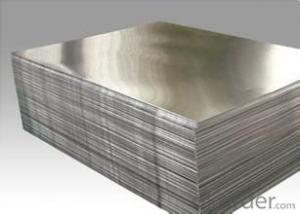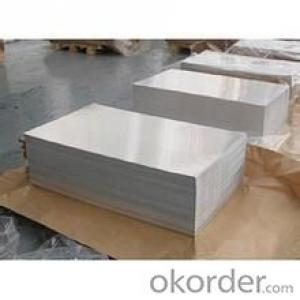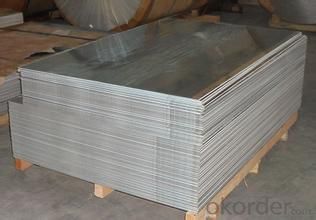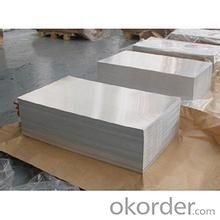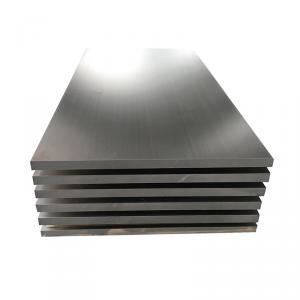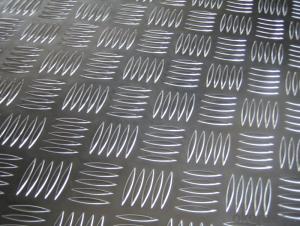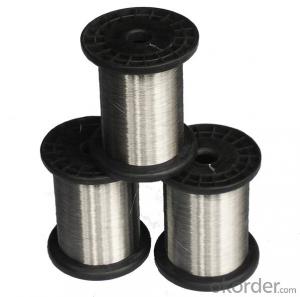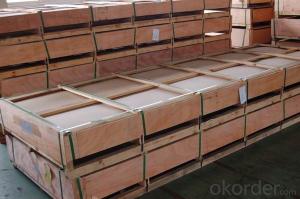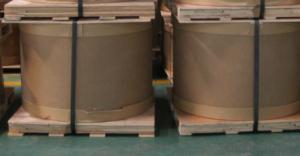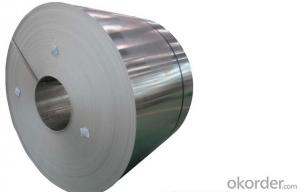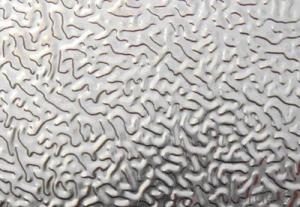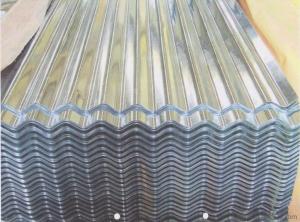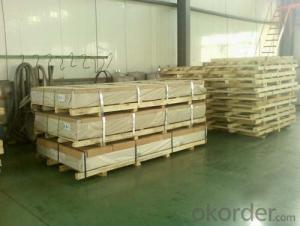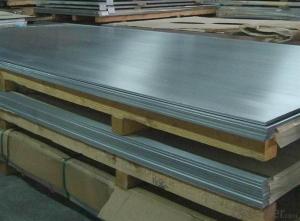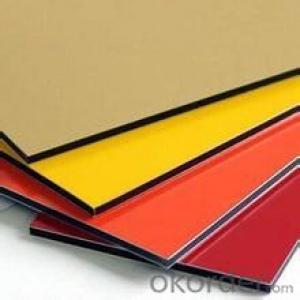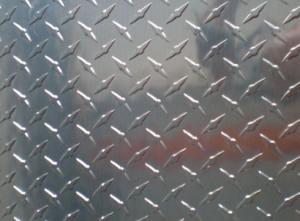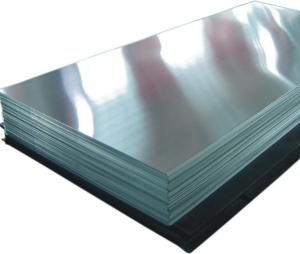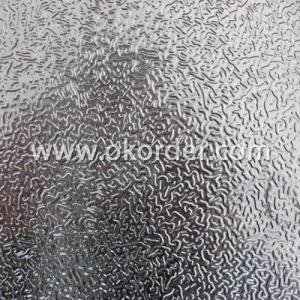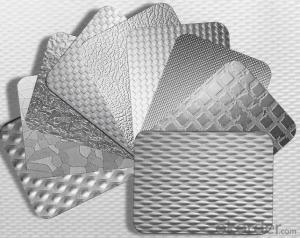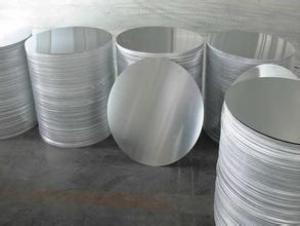Aluminum Metalized Pet Sheets 0.5 Mm - Aluminum Sheet and Corrugated Aluminum Sheet for Various Applications
- Loading Port:
- China main port
- Payment Terms:
- TT or LC
- Min Order Qty:
- 100 m.t.
- Supply Capability:
- 100 m.t./month
OKorder Service Pledge
OKorder Financial Service
You Might Also Like
Aluminium foil acts as a total barrier to light and oxygen (which cause fats to oxidise or become rancid), odours and flavours, moistness, and germs, it is used broadly in food and pharmaceutical packaging. The purpose of aluminium is to make long-life packs (aseptic processing|aseptic packaging) for drinks and dairy goods, which allows storing without refrigeration. Aluminium foil containers and trays are used to bake pies and to pack takeaway meals, ready snacks and long life pet foods.
Aluminium foil is widely sold into the consumer market, often in rolls of 500 mm (20 in) width and several metres in length.It is used for wrapping food in order to preserve it, for example, when storing leftover food in a refrigerator (where it serves the additional purpose of preventing odour exchange), when taking sandwiches on a journey, or when selling some kinds of take-away or fast food. Tex-Mex restaurants in the United States, for example, typically provide take-away burritos wrapped in aluminium foil.
Aluminium foils thicker than 25 μm (1 mil) are impermeable to oxygen and water. Foils thinner than this become slightly permeable due to minute pinholes caused by the production process.
Aluminium foil has a shiny side and a matte side. The shiny side is produced when the aluminium is rolled during the final pass. It is difficult to produce rollers with a gap fine enough to cope with the foil gauge, therefore, for the final pass, two sheets are rolled at the same time, doubling the thickness of the gauge at entry to the rollers. When the sheets are later separated, the inside surface is dull, and the outside surface is shiny. This difference in the finish has led to the perception that favouring a side has an effect when cooking. While many believe that the different properties keep heat out when wrapped with the shiny finish facing out, and keep heat in with the shiny finish facing inwards, the actual difference is imperceptible without instrumentation.The reflectivity of bright aluminium foil is 88% while dull embossed foil is about 80%.
We provide a full range of precision aluminum strip for almost any application. We produce aluminum strip in a wide variety of alloys, including clad composites. Our aluminum strip can be produced in standard dimensions or custom made to your special requirements. We produce both imperial and metric units. We manufacture in compliance with the main international specifications, and tighter tolerances or custom tempers are available upon request. We offer various surface conditions, custom finishes (painting, anodizing, embossing), special processing, and multiple packaging options to meet our customer's unique requirements. The following is a summary of our capabilities.
Manufactured in compliance with the main international specifications and standards, including: Aluminum Association, ASTM, EN, and DIN.
We can also manufacture in compliance with other international standards including:ASME, SAE, AMS, AWS, FED, MIL, QQ, ISO, BS, AFNOR, JIS and GOST.
Manufactured in compliance with the main international specifications and standards.
Tighter tolerances are available upon request.
Aluminium (or aluminum; see spelling differences) is a chemical element in the boron group with symbol Al and atomic number 13. It is a silvery white, soft, ductile metal. Aluminium is the third most abundant element (after oxygen and silicon), and the most abundant metal in the Earth's crust. It makes up about 8% by weight of the Earth's solid surface. Aluminium metal is so chemically reactive that native specimens are rare and limited to extreme reducing environments. Instead, it is found combined in over 270 different minerals.The chief ore of aluminium is bauxite.
Aluminium is remarkable for the metal's low density and for its ability to resist corrosion due to the phenomenon of passivation. Structural components made from aluminium and its alloys are vital to the aerospace industry and are important in other areas of transportation and structural materials. The most useful compounds of aluminium, at least on a weight basis, are the oxides and sulfates.
Despite its prevalence in the environment, no known form of life uses aluminium salts metabolically. In keeping with its pervasiveness, aluminium is well tolerated by plants and animals. Owing to their prevalence, potential beneficial (or otherwise) biological roles of aluminium compounds are of continuing interest.
The earliest citation given in the Oxford English Dictionary for any word used as a name for this element is alumium, which British chemist and inventor Humphry Davy employed in 1808 for the metal he was trying to isolate electrolytically from the mineral alumina. The citation is from the journal Philosophical Transactions of the Royal Society of London: "Had I been so fortunate as to have obtained more certain evidences on this subject, and to have procured the metallic substances I was in search of, I should have proposed for them the names of silicium, alumium, zirconium, and glucium."
Davy settled on aluminum by the time he published his 1812 book Chemical Philosophy: "This substance appears to contain a peculiar metal, but as yet Aluminum has not been obtained in a perfectly free state, though alloys of it with other metalline substances have been procured sufficiently distinct to indicate the probable nature of alumina."[69] But the same year, an anonymous contributor to the Quarterly Review, a British political-literary journal, in a review of Davy's book, objected to aluminum and proposed the name aluminium, "for so we shall take the liberty of writing the word, in preference to aluminum, which has a less classical sound."
The -ium suffix conformed to the precedent set in other newly discovered elements of the time: potassium, sodium, magnesium, calcium, and strontium (all of which Davy isolated himself). Nevertheless, -um spellings for elements were not unknown at the time, as for example platinum, known to Europeans since the 16th century, molybdenum, discovered in 1778, and tantalum, discovered in 1802. The -um suffix is consistent with the universal spelling alumina for the oxide (as opposed to aluminia), as lanthana is the oxide of lanthanum, and magnesia, ceria, and thoria are the oxides of magnesium, cerium, and thorium respectively.
The aluminum spelling is used in the Webster's Dictionary of 1828. In his advertising handbill for his new electrolytic method of producing the metal in 1892, Charles Martin Hall used the -um spelling, despite his constant use of the -ium spelling in all the patents[58] he filed between 1886 and 1903. It has consequently been suggested[by whom?] that the spelling reflects an easier-to-pronounce word with one fewer syllable, or that the spelling on the flyer was a mistake.[citation needed] Hall's domination of production of the metal ensured that aluminum became the standard English spelling in North America.
The features of corrugated aluminum sheet is light weight (only steel 3/10), silver white and other colors, both decorative effect, but also a strong ability to reflect sunlight. It can fire, moisture, corrosion resistance, can be used in the atmosphere for more than 20 years. Relocation dismantled corrugated board can still be reused. Aluminum corrugated sheet is widely used in building decoration. It is suitable for hotels, restaurants, shopping malls and other buildings walls and roof decorations.
Corrugated aluminum sheet is made of aluminum alloy rolled sheet, its wavy cross section, is currently building a new type of building material widely used.
Only one-third of the proportion of aluminum steel, and has good ductility, very suitable for rolling process, in addition to aluminum also has a strong corrosion resistance, and therefore have important applications in the construction industry.
Aluminum and oxygen in the air after the chemical reaction, the surface will generate layer strong and dense oxide film. This layer of aluminum oxide film preservation became "coat", the internal aluminum is difficult for them to oxygen in the air to oxidation, so aluminum is placed in the atmosphere a year, which is less than the depth of corrosion of thousands of hours one millimeter. If the same time into the aluminum and steel containing 3% of sodium chloride and 1% of the hydrogen chloride in the container, the corrosion test of 70 hours, the average weight loss of steel per square centimeter 11.07 mg in weight loss of aluminum average of 0.675 milligrams per square centimeter, which proves the corrosion resistance of aluminum is generally much higher than the steel. However, the natural oxide film of aluminum, there are still shortcomings thin and soft, corrosion is not very strong, so that the service life of corrugated sheet aluminum untreated generally only about 20 years. If aluminum by chemical oxidation (i.e., at a certain temperature of the aluminum oxide surface cleaning and liquid oxygen in a chemical reaction) or electrochemical oxidation (i.e. the aluminum into the electrolyte, in the role of the applied current and oxygen ions the method of a direct reaction of water with aluminum surface cleaning) are processed, on the surface of the aluminum layer will generate 0.025 to about 0.05 millimeters thick and hard and even more some of the oxide film, so as to further improve the corrosion resistance of aluminum performance. After aluminum corrugated sheets thus treated, the service life of up to 60 years. Aluminum corrugated sheets can also be a variety of bright colors, it is possible to make the building more beautiful.
Lightweight aluminum corrugated board, use it to do the roof, asbestos-cement tiles per square meter than about 20 kg lighter. Aluminum is easy to implement plastic molding, rolling aluminum corrugated sheet length is unlimited, so use can reduce the number of joints, thereby increasing coverage. In addition, the high strength aluminum alloy corrugated board, use it to make building materials, particularly useful in earthquake-prone areas.
In short, aluminum corrugated board is a light weight, high strength, fire, beautiful, shock, easy transportation and construction many advantages such as excellent building materials.
- Q: How to distinguish aluminum sheet from magnesium sheet?
- put them into acid and observe bubble's generating speed, the quicker one is magnesium sheet.
- Q: Can the aluminum sheets be used for manufacturing kitchen countertops?
- Yes, aluminum sheets can be used for manufacturing kitchen countertops.
- Q: Are aluminum sheets suitable for furniture manufacturing?
- Yes, aluminum sheets are suitable for furniture manufacturing. They are lightweight, durable, and resistant to corrosion, making them an excellent choice for various furniture applications. Additionally, aluminum can be easily shaped and fabricated, allowing for versatile designs and styles.
- Q: What are the different thicknesses available for aluminum sheet?
- Aluminum sheets come in various thicknesses, spanning from very thin to thick. The thickness of these sheets is measured either in gauge or millimeters (mm), with each gauge denoting a specific thickness. The prevalent gauges for aluminum sheets are 22, 24, 26, 28, 30, and 32, corresponding to thicknesses ranging from 0.0254 mm to 0.635 mm. Moreover, thicker gauges, such as 16 gauge (1.29 mm) or even more substantial ones, can be found for specialized applications. The preferred thickness of an aluminum sheet is determined by its intended use. Thinner sheets are often utilized for lightweight purposes, including electronics or packaging, while thicker sheets are more suitable for structural or industrial needs.
- Q: What are the different methods of surface treatment for aluminum sheets?
- Some of the different methods of surface treatment for aluminum sheets include anodizing, powder coating, painting, polishing, and brushing.
- Q: Are aluminum sheets non-magnetic?
- Yes, aluminum sheets are non-magnetic. Aluminum is not a ferromagnetic material, which means it does not have strong magnetic properties. It is classified as a paramagnetic material, which means it has a weak response to magnetic fields. Therefore, aluminum sheets do not attract or hold a magnet.
- Q: This question asks about the various color options available for aluminum sheets.
- <p>Aluminum sheets are available in a wide range of colors to suit various applications and aesthetic preferences. Common colors include silver (anodized), white, black, and clear (natural). Beyond these, there are also options for colors like red, blue, green, and yellow. Some manufacturers offer custom color matching services for specific projects. Additionally, aluminum sheets can be coated with various finishes such as matte, gloss, or textured, further expanding the color and appearance options. It's important to check with specific suppliers for their available color range as it can vary.</p>
- Q: Can aluminum sheets be used for battery casings?
- Indeed, battery casings can be made using aluminum sheets. Aluminum, a metal that is both lightweight and durable, possesses superb corrosion resistance, making it an ideal option for battery casings. Moreover, aluminum exhibits excellent electrical conductivity, a crucial factor for optimizing battery efficiency. Furthermore, aluminum can be easily molded and formed into diverse shapes and sizes, granting flexibility in battery casing fabrication. In conclusion, due to its advantageous characteristics, aluminum sheets are widely employed in battery casing production.
- Q: Can aluminum sheets be used for electronic enclosures?
- Yes, aluminum sheets can be used for electronic enclosures. Aluminum is a lightweight and durable material that offers excellent heat dissipation properties, making it suitable for protecting electronic components. Additionally, aluminum sheets can be easily fabricated to create custom enclosures that provide electromagnetic shielding and protection against environmental factors.
- Q: What are the different alloys used in aluminum sheets?
- Some of the different alloys used in aluminum sheets include 1100, 3003, 5052, and 6061.
Send your message to us
Aluminum Metalized Pet Sheets 0.5 Mm - Aluminum Sheet and Corrugated Aluminum Sheet for Various Applications
- Loading Port:
- China main port
- Payment Terms:
- TT or LC
- Min Order Qty:
- 100 m.t.
- Supply Capability:
- 100 m.t./month
OKorder Service Pledge
OKorder Financial Service
Similar products
Hot products
Hot Searches
Related keywords
